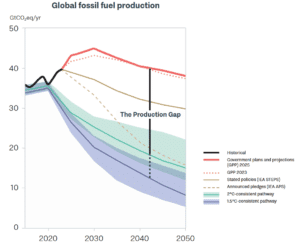Stockholm (NordSIP) – As nations prepare their updated Nationally Determined Contributions (NDCs) ahead of the 30th Conference of the Parties to the United Nations Framework Convention on Climate Change (COP30), the latest iteration of the Production Gap Report raises serious questions about the climate commitments of major oil producing countries.
The Production Gap Report was first issued in 2019 and is the product of a collaboration between the Stockholm Environment Institute (SEI), Berlin-based NGO Climate Analytics, and the International Institute for Sustainable Development (IISD). The report is based on the analysis of the fossil fuel production plans of 20 major countries, which are together responsible for about 80% of global fossil fuel production. This is contrasted with the remaining carbon budget for the 1.5-degree and 2-degree global warming targets set out in the Paris Climate Agreement.

Source: productiongap.org
In the previous Production Gap Report published in 2023, the countries’ combined fossil fuel production output was 110% above the 1.5°C warming pathway and 69% more than the 2°C pathway. Unfortunately, in the interim 2 years these gaps have risen to 120% and 77% respectively, a worrying trend highlighted by Derik Broekhoff, coordinating lead author of the Production Gap Report and Climate Policy Program Director at SEI’s U.S. Center: “In 2023, governments formally acknowledged the need to move away from fossil fuels to mitigate climate change—an obligation the International Court of Justice has now clearly emphasised but as our report makes clear, while many countries have committed to a clean energy transition, many others appear to be stuck using a fossil fuel-dependent playbook, planning even more production than they were 2 years ago.”
Among the few positive outcomes in the 2025 report are the six nations that have developed domestic fossil fuel productions scenarios that are aligned with net-zero targets, up from only four in 2023. Nevertheless, 11 out of the 20 countries have increased their near-term production plans for at least one of the three main fossil fuels compared with their 2023 projections. The United States (US), Saudi Arabia, Russia, Canada, China, the UAE, and Brazil all plan increases in oil production towards 2030. The latter country is the host of the upcoming COP30 due to take place from 10 – 21 November 2025. While its latest NDC includes a targeted reduction in net greenhouse gas (GHG) emissions by 59–67% by 2035 compared to 2005 levels, Brazil expects its oil and gas production to keep growing over the near-term.
The countries on a relatively compatible pathway include the United Kingdom (UK) and Norway. The UK completely phased out coal-fired electricity generation in September 2024 and has a legally binding 2050 net-zero target. Norway’s government adopted a target in 2020 to cut emissions from oil and gas production by 50% by 2030 relative to 2005 levels. However, its current production plans and continued licensing of new North Sea exploration risk jeopardising this target.
Christiana Figueres, former Executive Secretary of the UNFCCC, sought to emphasise the overall incompatibility between these 20 nations’ climate commitments and their current and planned actions: “Let this report be both a warning and a guide. Renewables will inevitably crowd out fossil fuels completely, but we need deliberate action now to close the gap on time. We have the technology. We have the economics, and we have the legal clarity. What we need now is courage and solidarity to move forward at great speed with the just transition.”




